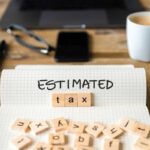
One of the most important parts of tax planning is quarterly estimated tax payments. Estimates are required to be paid by certain individuals, trusts, and businesses. These payments are made by taxpayers to avoid what is referred as “underpayment penalties”. Many taxpayers can avoid underpayment penalties by income tax withholdings from salary, but other taxpayers must avoid underpayment penalties by submitting estimated payments.
Who should make quarterly estimated tax payments? The general rule for individual taxpayers is if you owe more than $1,000 in federal taxes, you should be making estimated tax payments. The state tax liability threshold amounts are slightly different from the federal amounts. Individual taxpayers should make state (California) estimated payments if their tax liability will be more than $500 (married filing jointly) or $250 (single).
As previously mentioned, these are quarterly estimated tax payments. So, what does this mean? This means that a taxpayer will be making four payments to prevent paying interest and penalties on top of the tax liability. Federal and California quarterly tax payment amounts due are both different. Although, the due dates remain the same. The federal and California quarterly tax payment schedule is as follows:
|
Due Date: |
Federal (IRS): |
California (FTB): |
|
Quarter 1 APRIL 15 |
25% | 30% |
|
Quarter 2 JUNE 15 |
25% | 40% |
|
Quarter 3 SEPTEMBER 15 |
25% |
0% |
| Quarter 4
JANUARY 15 |
25% |
30% |
If you don’t pay enough tax by the due date of each payment period, you may be charged a penalty even if you’re due a refund when you file your income tax return at the end of the year. Generally, if you determine you need to make estimated tax payments for estimated income tax and estimated self-employment tax, you can make quarterly estimated tax payments or pay all the amount due on the first quarterly payment due date.
Federal Individual Estimated Payments – Safe Harbor Rules
Generally, taxpayers must make estimated tax payments for the current tax year if both of the following apply:
- You expect to owe at least $1,000 in tax for the current tax year after subtracting your withholding and refundable credits, and
- You expect your withholding and refundable credits to be less than the smaller of:
- 90% of current year’s tax OR
- 100% of the preceding year’s tax (110% when the adjusted gross income was more than $150,000 or $75,000 if married filing separately), if such year was a full tax year.
California Individual Estimated Payments – Safe Harbor Rules
Generally, taxpayers can avoid paying California penalties for underpayment of estimated taxes by paying the lesser of the following:
- 90% of the current year’s tax, or
- 100% of the preceding year’s tax (110% when the adjusted gross income was more than $150,000 or $75,000 if married filing separately).
- But high-income taxpayers must meet some different standards as listed below:
- Individuals with annual AGI of $1,000,000 or more must pay in 90% of the current year’s tax to avoid a penalty.
Trusts are generally required to make estimated tax payments in the same manner as individuals. Also, there are special rules that apply to farmers and fisherman. Farmers and fishermen make one required payment or pay in full along with their tax return when filed by a certain date.
Both Federal and California allow what is referred to as annualization. That is each estimated payment due date is based on income for the months preceding the estimated due date which is then annualized to compute the tax that the estimate will be based on. This method is appealing where income is generated in the later months of the year. Generally, annualization is not preferable when there is large income at the beginning of the year.
More information on who is required to make quarterly tax payments, when they are due, and how to make the payments, can be found on the IRS and FTB website.
https://www.irs.gov/businesses/small-businesses-self-employed/estimated-taxes
https://www.ftb.ca.gov/forms/2020/2020-540-es-instructions.html
https://www.ftb.ca.gov/forms/2020/2020-100-es-instructions.html
written by Ashley Woodhouse



